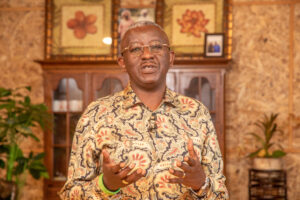I recently took part in a Pan African Climate Change Earth Summit hosted at the Kenya Wildlife Service. While observing the discussions, the pressing need to innovatively finance transition to clean energy became evident to me, hence these thoughts.
Last year in Kenya, 700,000 new customers were connected to the electricity grid, marking a significant stride toward connecting every Kenyan to the grid. Unlike various western countries relying on unclean energy sources like coal, 87 percent of electricity generated in Kenya last year came from renewable sources such as geothermal and wind. In contrast, the US generates about 60% of its electricity from fossil fuels including coal, natural gas, petroleum, and other gases.
Kenya stands as a global leader in electricity generation from renewable sources. Nevertheless, this accomplishment could obscure the heavy reliance on non-renewable sources like fossil fuels and biomass such as charcoal for transport fuel and cooking energy, posing severe economic and health risks.
Without any doubt, the escalating fuel costs pose a critical inflation risk, impacting transportation and manufacturing expenses. Additionally, rising fuel prices contribute to increased food prices. The reliance on fossil fuels in Kenya and globally is no longer sustainable, demanding urgent and decisive action to shift the transport sector away from these fuels.
Fortunately, Kenya has already embarked on critical steps that need amplification. The government’s initiative to introduce electric buses and establish charging stations in remote regions not only enhances mobility but also reduces emissions, fostering a cleaner transportation system. Moreover, the full implementation of the Finance Act effective from July 1, 2023, zero-rating VAT on the importation or sale of e‑Mobility vehicles and components, such as electric bicycles and motorcycles, is imperative.
As we transition, there is need to move with all players stepping on a reasonable policy foundation that we have already laid regarding localization. In Indonesia, Ministerial Regulation No. 21 of 2023 offers a subsidy of approximately USD 600 to buyers of electric motorcycles, reducing the original price. Such is the supportive approach that our Automotive Policy must breathe.
Regarding cooking fuel, approximately 70 percent of Kenyan households still rely on biomass, exposing them to health risks due to indoor air pollution. Regrettably, 23,000 Kenyans perish annually due to the use of kerosene and firewood for cooking. The transition to clean cooking energy is a life-and-death matter.
President William Ruto’s target of achieving 100 percent access to clean cooking by 2028 may be deemed ambitious by critics, but I am convinced of its feasibility. To expedite this goal, I suggest that the President accelerates the implementation of the energy transition program, mandating all public institutions to shift from biomass cooking fuels to cleaner options. Additionally, substantial investment in biogas is pivotal for this transition.
At the household level, increasing LPG usage is crucial. Presently, only 24 percent of Kenyan households use LPG, while 56 percent use kerosene. The government’s plan to provide free LPG cylinders to 4.4 million impoverished households by 2025 is commendable and should be executed. Additionally, the affordable housing projects must be designed with energy transition in mind.
Transitioning to renewable energy through these proposals entails significant costs and here is my suggested practical solution.
Carbon offsetting which has mushroomed into a global multibillion-dollar industry presents a viable financing mechanism for this envisioned energy transition. It enables individuals or organizations to offset their carbon emissions by investing in carbon reduction projects. In Kenya, for instance a small project at the Chyulu Hills REDD+ Carbon Project, aiming to support community livelihoods and conserve the Chyulu Hills landscape receives USD 6 per ton for the 600,000 tons of carbon that is offset by the forest. This amounts to USD 3.6 M annually. Painfully, very many such projects worth trillions exist in Kenya. Despite organizers reaping billions from selling carbon credits, only a fraction trickles down to the community. At such economically challenging times as now, isn’t this money that we can innovatively apply to drive the transition to renewable energy? Tusijitese. Think green, act green!



